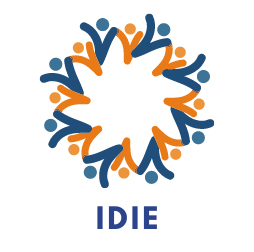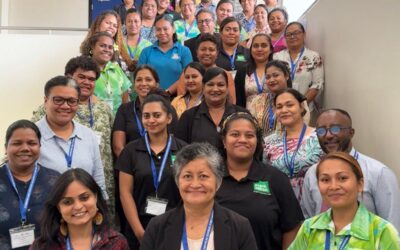As part of my second summer in the Laidlaw Leadership and Research Program, I joined the Infectious Diseases, Immunizations, and Emergencies (IDIE) research group based at the Sydney School of Public Health, the University of Sydney, Australia as a student researcher. I am a student at Cornell University majoring in Biological Sciences with a minor in Community Food Systems. My interests lie at the intersection of health, social justice, and the environment. The Laidlaw Program provides funding for two summers of internationally-focused research.
In December 2023, I reached out to Professor Sheel whose work studies infectious disease transmission, prevention, and control using epidemiology. I was excited by the opportunity to work in the Pacific Island context, an area of the world new to me with unique geography and culture. Pacific island countries and territories are also disproportionately vulnerable to the effects of climate change which will weaken their healthcare systems and increase infectious disease. I was also eager to gain qualitative research experience to understand public health issues through a health systems lens. I was curious about stakeholders involved in health care besides those working directly with patients. My past research experience and academic focus have been on the biological mechanisms of disease and modeling how environmental factors affect vector-borne disease transmission. My goal was to extend my knowledge of infectious disease to the community and population level to gain a holistic view of health. Quality and access to healthcare, such as vaccines, are social determinants of health. This research experience on immunization and infectious diseases allowed me to expand my interests in the social determinants of health and health equity. During my eight weeks, I was involved in three projects/ activities which helped shape my experience: analyzing qualitative interviews with health system actors in Vanuatu, creating a measles database, and attending the 2024 Global Health Security Conference. I also attended regular IDIE team meetings and participated in professional development workshops through the ARTS2600 course.
Activity 1: Using digital tools to strengthen immunization systems: a case study of the District Health Information System 2 in Vanuatu
Aim:
Electronic Immunization Records (EIRs) can improve the collection, flow, and dissemination of data between levels of the health system which allows data to be used to inform decision-making and action. The use of immunization data in low and middle-income countries is understudied. I supported Cyra Patel’s PhD case study on Vanuatu’s use of an EIR implemented for COVID-19 vaccines during the pandemic and its future applications to replace current paper-based methods for routine immunizations. I aimed to understand how different levels of the health system work together and how data are used to inform healthcare decisions and actions, such as where to allocate resources.
Methods:
I analyzed stakeholder interviews from informants working at the Ministry of Health at the national, provincial, and health facility levels and within international development agencies such as WHO and UNICEF. I coded the interviews using the software NVivo. The interviews provided insight into the experience of using the EIR and the possibility of transitioning from traditional methods of data collection (i.e. paper-based methods and aggregate data reporting) to the digital system. I also performed a document review, a research method that analyzes and interprets documents relevant to the. My goal was to better understand the current data collection system and training resources available.
Expected outcomes:
Unpublished preliminary results indicate that the EIR facilitated faster data collection, analysis, and dissemination compared to traditional routine immunization practices. Informants discussed how the COVID-19 pandemic context contributed to the success of the EIR due to factors such as increased human resources, internet coverage, and demand for data. Informants expressed support for using the EIR for routine immunizations but expressed concern that factors, such as the workload burden on nurses and lack of data use culture might hinder implementation. Findings from this study will inform Vanuatu digital health and vaccine programs and policy.
Reflections:
This project is led by PhD scholar Cyra Patel. I supported Cyra in the analysis of the qualitative data. I enjoyed working with Cyra as we worked to finalize the coding themes and framework, compared our coding, and discussed our findings. It took patience and attention to detail to transcribe interviews and tweak the coding framework so that it worked well in the context of the interviews. It was exciting to pull out common themes and build a narrative from the interviews! I also gained diverse perspectives as the interviews were from stakeholders at multiple levels of the healthcare system. It was interesting to hear nurses at the health facility level discuss challenges with maintaining a healthcare workforce while hearing informants at the provincial and national levels discuss challenges with vaccination data reporting and analysis. In countries such as the U.S. and Australia, I took for granted how the electronic health system elevates the quality of patient care compared to countries who do not have one. The interview coding process and document review allowed me to build a deeper understanding of how the Vanuatu health system works and how an EIR can improve it. Contributing to data analysis for the Vanuatu study allowed me to experience qualitative research that expanded my interests in the social determinants of health and healthy equity.
Activity 2: Predicting measles outbreak in the Pacific Island Countries and Areas in the era of vaccination and elimination
Aim:
The 2019-2020 measles outbreak in the Pacific Island Countries (PICs) was likely influenced by reduced vaccination coverage. The broader goal of this study is to use epidemiological and mathematical models to predict the rate of build-up of susceptible populations and predict future measles outbreaks in the PICs. My goal was to understand the series of events leading up to this measles outbreak and extract open-source data to start a database for this study.
Methods:
I reviewed literature on immunizations, measles, and lessons learned from this specific outbreak. I worked with Professor Sheel to determine which variables to focus on and identify data sources. I created an Excel spreadsheet with data from 2000-2023 for variables such as measles vaccine coverage, population denominator, incidence, and reported cases. I used data sources from World Health Organization (WHO) and the Pacific Community (SPC) databases.
Expected Outcomes:
Findings from this project will inform measles vaccine policy and programs in the PIC context. I look forward to seeing where this project goes!
Reflections:
Although this study is focused on mathematical modeling, I was able to familiarize myself with vaccine-preventable diseases and measles in general, an area I had minimal exposure to. I was exposed to using large datasets and using open-source data. This complemented my work on the Vanuatu study as measles vaccines are part of routine immunization programs. I better understood barriers to routine vaccination and a real-world scenario of a vaccine-preventable disease outbreak.
Activity 3: Global Health Security Conference 2024, Sydney, Australia
A highlight of my summer was the opportunity to attend the Global Health Security Conference held in Sydney. I learned about public health policy and interventions, a field new to me. My favorite sessions included discussions on water, sanitation, and hygiene (WASH), floods and malaria outbreaks, and urbanization and health security. I was curious about disease prevention and treatment programs related to climate change, vector-borne pathogens, urbanization, and disease spread. Learning about these issues from a health security lens complemented my research on mosquito biology and malaria transmission at Cornell. A holistic view of both the biological mechanisms and social determinants of disease spread is crucial to my understanding of the subject. The conference allowed me to expand my academic knowledge developed at Cornell to real-world issues and research.
I also attended a Roundtable discussion on Building the Public Health, and Emergency Preparedness and Response Workforce, hosted by members of the IDIE group. Since the discussion was on the first day of the conference, it allowed me to view the rest of the panels through a health workforce lens. The issue came up in the majority of sessions I attended such as panels discussing the lack of proper-fitting and safe personal protective equipment for women healthcare workers and how the COVID-19 pandemic highlighted the need for an effectively coordinated and diverse public health workforce. Experts representing many countries and important organizations discussed workforce issues in their respective countries and the potential role of WHO’s Roadmap to build a public health and emergency response workforce and the Essential Public Health Functions (EPHFs) in their communities. The Roadmap is a framework to help countries map and measure their workforce and assess skills and capacity to deliver EPHFs. I enjoyed how the discussion emphasized collaboration across disciplines to combine government leadership, field epidemiology, and One Health approaches. Since the conference was held in Sydney, I was eager to hear insights from representatives from the Asia-Pacific region. Delegates from Fiji and Papua New Guinea discussed challenges with training and maintaining the healthcare workforce, limitations experienced across small Pacific Island Countries. I was able to make connections to IDIE’s research on digital immunization systems in Vanuatu as the workforce is also a major challenge. I have a deeper understanding of how the workforce is the driving force of the entire healthcare system. Lack of workforce or stressors on healthcare workers impact social determinants of health such as access to health care and quality of healthcare. As I learn and think critically about health issues in my career, I will remember this workforce discussion. I am very grateful for this opportunity to learn from such high-level experts and gain a deeper understanding of health issues and the different actors that make up the healthcare system.
Aside from the scientific content of this discussion, I learned how delegates from different nations and organizations interact and collaborate on global issues. I was inspired by how delegates shared their country’s specific problems and other delegates provided advice and insight into how they addressed those issues. Global health issues can often seem large and difficult to tackle. Witnessing a discussion like this showed me how change is effected and how nations are working together with the same goals in mind. The conversations left me feeling optimistic and showed me many different career paths within global health.
Other highlights of the conference included the plenary session on Women in Global Health Leadership and a meet and greet with Australia’s Women in Global Health chapter. Starting the conference with this session was powerful. I was inspired by how speakers such as Precious Matsoso, Co-chair of the Intergovernmental Negotiating Body to Draft an agreement on pandemic prevention, preparedness, and response, spoke about her experience as the only woman on the Pandemic Accord panel. I am grateful to have role models like the panel speakers and mentors like Professor Sheel to look up to as leaders and changemakers. I reflected on who I am and how I can be a leader in my career. I felt the strong community among these women and aim to create a similar community of women in science at different stages of my future career path. While the conference began with conversations on gender equity and representation, it struck me that the delegates participating in the Roundtable discussion were mostly men. Although there is more representation of women in leadership roles, there is still room for improvement.
Conclusion and Acknowledgements
Through this experience, I grew professionally while expanding my research skills, contributing to data collection to answer real-world healthcare problems, and experiencing how researchers collaborate globally to solve the world’s most urgent problems and make a difference in communities. I am grateful for the mentorship and friendship from the IDIE group and am excited to stay involved with the research! This was a pivotal experience that piqued my interest in public health and qualitative research. The work allowed me to dive deeper into the socio-ecological factors of health which complement my biological knowledge. Overall, I had an amazing time where I enjoyed being part of the IDIE community and exploring the beautiful city of Sydney. Thank you to Professor Sheel and Cyra Patel for their mentorship and for the opportunity to contribute to their projects. Thank you to the entire IDIE team for their guidance and friendship. Lastly, thank you to the Laidlaw Foundation and Cornell University for funding this 8-week opportunity in Summer, 2024.

Here are some photos I took! The collage includes pictures of the IDIE team, me at the Global Health Security Conference, views from the Bondi to Coogee walk and Palm Beach, the Sydney Opera House, Australian animals I saw (kangaroo, wombat, cassowary), and the Great Barrier Reef.



